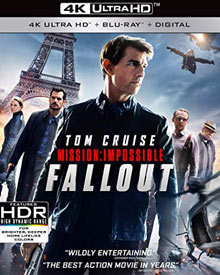
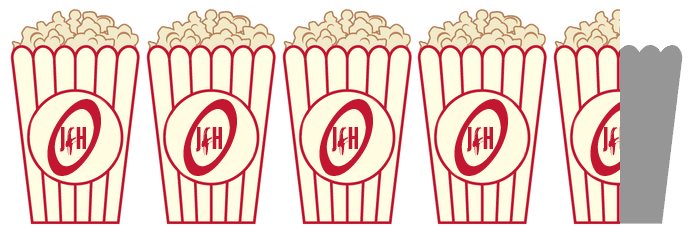
 - for violence and intense sequences of action, and for brief strong language
- for violence and intense sequences of action, and for brief strong language
Ethan Hunt and his IMF team, along with some familiar allies, race against time after a mission gone wrong. (from IMDB)
It's unlikely that, back when the first Mission: Impossible film released in 1996, anyone could have predicted the franchise would still be going strong 22 years later. The popular 1960's television-show-turned-modern-movie-franchise hasn't had a perfect run, but it's one that has actually improved with almost every entry... except for that first sequel, that is. 1996's Mission: Impossible was the quintessential 90's action spy flick, but it mixed in a twisty-turny plot that ended up frustrating the average moviegoer. It wasn't till 2000 that a sequel followed, and that one used the overly stylized touches of director John Woo to catapult the franchise full-on into La La Land. It was entertaining at the time, but it hasn't aged well (at all), and fits absolutely nowhere in the grand scheme of the franchise. The only constant between Mission: Impossible II and the rest of the series is that it stars Tom Cruise as Ethan Hunt (but barely acting like Ethan Hunt) and Ving Rhames as Luther Stickell. Otherwise, it does nothing for the series.
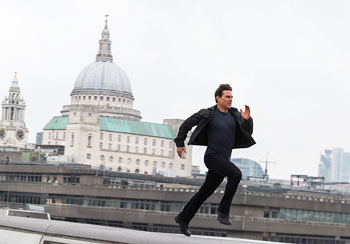
But that all changed in 2006 when J.J. Abrams resuscitated the Mission: Impossible brand, centering the story around Ethan Hunt's humanity and his attempts to find a normal life amidst his day-to-day as an IMF agent (who apparently wasn't even in the field anymore). The movie is still a gripping action thriller that seems to be the start of something truly special. Five years later, we finally got the fourth film, Ghost Protocol (they decided to drop the numbering), and this time, The Incredibles director Brad Bird took over directorial duties. This is the movie that really started to highlight Tom Cruise's death-defying stunt performing. It's this fourth Mission where Tom actually climbed outside and onto the tallest building in the world, the Burj Khalifa in Dubai... and it's a truly incredible sequence.
We didn't get a follow-up for another four years, however, when Rogue Nation released in 2015. And just when naysayers were ready to write off "yet another Mission: Impossible" movie, it turned out to be one of the best yet (if not the best). Ethan finally went up against The Syndicate and once again was on the run against one of his greatest foes. It did well at the box office, too, so much so that a follow-up was announced shortly thereafter and we now have the sixth installment -- Mission: Impossible: Fallout. It creates a bit of a trilogy with a narrative that flows between Ghost Protocol, Rogue Nation, and Fallout, but it also develops a major plot point from Mission: Impossible III, giving us a satisfying film that is the pay-off of 12 years of great story-building.
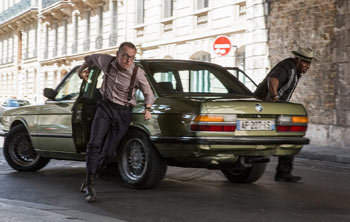
Fallout is set up to be what Spectre was supposed to be for the newest James Bond franchise. For Spectre, it was the second film in a row to use the same director, and it was coming off of the surprise success (critically and financially) of Skyfall. Spectre set out to do exactly what Fallout accomplishes -- take the consequences of the central hero's actions and threads started from previous films, and bring them all together (and to a rolling boil). Spectre tried to do this, but it never felt natural. It felt forced. It tried to unite things from previous films that were never meant to be united and couldn't possibly have been related to each other, all while hanging it on a new villain who supposedly had a personal history with Bond. It was a mess. An entertaining mess, yes, but a mess no less.
Fallout is a big, emotional crescendo for the character of Ethan Hunt. He's proven time and again throughout the series to be the hero. A hero you want on your side, and a hero you can look up to. He gets beaten up - to the point of near death - and comes back for more. We've seen him risk everything to save a friend and it always has some kind of consequence. In Fallout, we see just what those consequences are (and could be), and Ethan is pushed to the brink where the viewer wonders if he's actually going to have to violate his core values to get the job done. It becomes a nail-biter in the process.
There are actually moments where, strangely, Fallout feels like Christopher Nolan's The Dark Knight -- in a good way. One action sequence occurs entirely silently with only Lorne Balfe's intense score playing, and it feels like one of those gritty Nolan moments where he steps back to let Hans Zimmer feed the emotion to the viewer with the film's score. In fact, Balfe mimics The Dark Knight theme at points in the film ("Change of Plan" on the film's score is a good example, while "The Exchange" has a Dark Knight Rises vibe), which only reinforces this feeling. (To be fair, he's actually collaborated with Zimmer over the years, so that could explain this.) But Balfe's score is overall darker and more intense and epic than the scores from the previous films (which I've often totally loved. Danny Elfman did the first film, Zimmer the second, Michael Giacchino 3 and 4, and Joe Kraemer did 5). The score for Rogue Nation had been one of the series' best, capturing a fun, thematic action score, but the darkness and frenetic feel that Balfe captures only ups the intensity factor for Fallout's overall ambience.
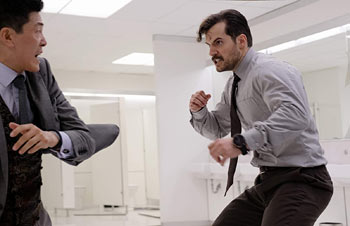
It didn't hurt that I had rewatched all five previous films in the days leading up to seeing Fallout either. Doing so had helped to make Rogue Nation an incredible ride at the theater when I saw it three years ago, and it had a similar effect here. You can't appreciate all the nods to the previous films and its story progressions and character developments without having it fresh in your mind. Fallout beautifully carries the story forward while raising the stakes for our heroes. Also, Fallout is a direct sequel to Rogue Nation, so it really helps to know what happened in that film when seeing this one. Given that it seemed Cruise's original plan was to keep each film separate and standalone, it's obvious to see how solid the past 4 films have been once they started building off of each other. But Fallout doesn't ignore the 1996 original at all. In fact, there's a significant nod to Max, the arms dealer, who had been played by Vanessa Redgrave. In this film, Ethan walks in on some kind of reception where a young woman who sounds remarkably like Redgrave is talking about Max and her love for "paradoxes" (as Max referred to Ethan in the first film). It's pretty subtle, and only original fans would catch it, but it felt like a little fan appreciation moment.
IMAX is really the perfect viewing format for Mission: Impossible Fallout. You could tell when the screen expanded for the moments that were shot with IMAX cameras -- like Ethan's insane helicopter stunts near the end, for example. The action scenes were frequently thrilling and nerve-racking too, which just added to the overall film. And it's a thrill to not only have Rebecca Ferguson reprise her role from Rogue Nation, but have Simon Pegg back for his fourth straight outing. He adds a lot to these movies - especially some light, well-placed humor, and it's also great to see him get involved more in some action sequences. But it was especially great to have a story like this that also stirs in plenty of emotional weight as well as even some ethical questions to chew on (like Ethan's struggle with getting the job done while still being able to do the right thing). There are also several fantastic twists in the story that are shocking and ones you just don't see coming, and that just makes this ride even more fun to be on.
The content was rougher, in some ways, than previous Mission films. This installment probably has the most profanity of any of the previous movies, unfortunately. Henry Cavill's August Walker even drops the franchise's first "F" word at one point, which was also disappointing (Superman, no!). The very first film had some bloody moments for sure, and this one definitely does, although it isn't all that gratuitous. A character is shot in the face, but we never see the wound. However, we see a large pool of blood on the floor and see others' reactions to how horrific the sight must be (and a comment is made that the man "doesn't have a face" anymore). Other scenes have some brutal action - like stabbing and even characters getting shot - that aren't bloody at all, but the motions and actions are certainly brutal or violent. Some really rough scenes take place at the end of the film, with characters being brutally strangled with ropes and such, and one character's face gets severely burned and somewhat melted, which we see for a few scenes. Overall, this movie is really intense, and not appropriate for young viewers.
If you're a fan of the franchise, Fallout feels like a natural story progression and just what we've been waiting for. It's excellent, and easily one of the year's best films. I'd love to see the team out for another Mission, but I can't imagine how it could continue to just get better from here.
- John DiBiase (reviewed: 7/27/18)
In the theaters, I had the pleasure of seeing Mission: Impossible - Fallout in a couple different formats, including on IMAX and in 3D. The 4K UHD transfer is beautiful, but the scenes that really, really stand out are the ones that were shot in IMAX--particularly the HALO jump sequence and the climactic helicopter chase. And considering that Cruise did all of his own stunts and much of the footage we see is real, it makes it that much more breathtaking. The crystal clear and vivid images of the helicopter chase are especially jaw-dropping. For those wondering, the aspect ratio does change for both scenes, too, growing taller to show more of the IMAX shot on our TVs. I love the creativity of the screen growing in size as Hunt approaches the back of the airplane to jump out. Just brilliant. You literally feel the sky approaching in that shot. If you like 4K, definitely grab this one in that format (or, at the very least, the blu-ray).
The regular Blu-Ray set has a bonus disc with special features. The digital copy offers these as well:
Behind the Fallout (54:04) - This feature-length making-of featurette is available in the following segments or viewable together with a Play All option.
Light the Fuse (11:09) - This featurette kicks things off, talking about how everything we've seen in the previous five films was leading up to this one; it’s a culmination of all of them. They talk about uniting--and reuniting--the cast, as well as aiming to resolve the love story between Ethan and Julia that was established in Mission: Impossible III. The rest of this segment addresses the director's involvement, pulling out all the stops for this one, and shooting in IMAX format.
Top of the World (10:48) focuses on the famed HALO jump sequence. Tom Cruise trained in Abu Dhabi, and practiced on a wind tunnel that was built especially for this practicing it. They ended up filming the jump in three parts and did over 100 jumps to test, practice, and shoot the sequence!
The Big Swing: Deleted Scene Breakdown (3:44) - Seeing this here, I had actually forgotten that this sequence was in the trailer but not the finished film. Following the HALO jump scene, Hunt and Walker were supposed to have a near-death experience while trying to get into the building. Cruise and Cavill really dangled 200 feet in the air above the floor, but they inevitably cut this sequence. We get to see it in the deleted scenes montage, and while it was a cool stunt, it just wasn't needed in the movie.
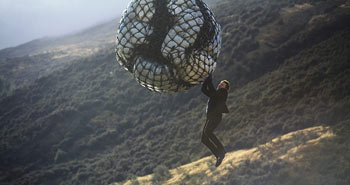
Rendezvous in Paris (7:20) - The team shot 8 weeks in Paris and are big fans of the city. Tom did his own stunt driving through the streets of Paris during the car chase. Simon Pegg even reflects that they didn't even have to "act" in the scenes -- the fear and surprise on their face was real.
The Fall (5:56) - This was about Tom's drop from underneath the helicopter. They filmed it in two pieces and he did it 4 or 5 times! (1 "g*dd*mn")
The Hunt is On (11:07) - New Zealand stood in for the location of Kashmir. This segment talks about shooting there, Tom practicing flying a helicopter, and more on that sequence. (1 "S" word, 2 "Oh my G-d")
Cliffside Clash (4:01) - The final segment of "Behind the Fallout" covers shooting the climactic fist-fight filmed on Pulpit Rock in Norway, and how dangerous it was to actually fight right there on location without a green screen!
Deleted Scenes Montage (3:35) — This is a montage of scene pieces set to just music, with no dialog. First we see the "Big Swing" scene mentioned earlier in the behind-the-scenes with the cord snapping above the dance party. Other moments include tying up Solomon, the IMF team arriving at an outpost where they find murdered soldiers (in Kashmir?), additional footage added to scenes here and there, etc. There were some really beautifully shot and composed moments that ultimately went unused.
Deleted Scenes Montage with Commentary (3:35) - Director Christopher McQuarrie explains why pieces were cut and how he doesn’t believe in director's cuts of films. He likes his final edit to be the final version of the movie. (He even doesn't believe in sharing deleted scenes on home releases like this.) Here, he points out that some of the footage was even in the trailers, but went unused. And that there's an alternate ending where we basically see Ilsa and Ethan walk off together at night.
Foot Chase Musical Breakdown (4:50) - Here we see the foot chase sequence with composer, Lorne Balfe, talking about the music, breaking it down into separate sections -- like percussion, strings, etc, as the scene plays out on screen.
The Ultimate Mission (2:50) - This is a summary of everything we saw in the behind-the-scenes section, but it also shows some neat wire work from the bathroom fight for a second, and some more stuff that hadn't been shown in that longer featurette.
Theatrical Trailer (2:29) - This is one of the final trailers for the film that does not show the deleted sequences. (You may have to go to YouTube for those.)
Commentaries (2:27:24 each) - There are three separate feature-length commentary tracks. The first is Commentary by director Christopher McQuarrie and editor Eddie Hamilton. The next is a Commentary track by director Christopher McQuarrie and Tom Cruise, and the last one is Commentary by composer Lorne Balfe.
Isolated Score Track (2:27:24) - Here, you can watch the entire film with only the music by composer Lorne Balfe playing.
Storyboards - There are four Storyboard galleries, presented as frames or viewable via a slide show. They include: "Paris," "What If?," "London," and "Helicopter."
Finally, we have a set of Photo Galleries, featuring promo images and set stills for each of the following categories: "Tom Cruise," "Christopher McQuarrie," "Collaboration," "Action in the Air," "Action on Land," "Capturing the Action," "Rob Hardy," and "Supporting Cast."
- John DiBiase, (reviewed: 11/30/18)
Disclaimer: All reviews are based solely on the opinions of the reviewer. Most reviews are rated on how the reviewer enjoyed the film overall, not exclusively on content. However, if the content really affects the reviewer's opinion and experience of the film, it will definitely affect the reviewer's overall rating.
 for KING + COUNTRY's "Do You Hear What I Hear" Goes Gold for KING + COUNTRY's "Do You Hear What I Hear" Goes GoldTue, 16 Dec 2025 18:25:00 EST |
 Provident Entertainment Named Billboard's Top Christian Label for 2025 Provident Entertainment Named Billboard's Top Christian Label for 2025Tue, 16 Dec 2025 18:15:00 EST |
 Tribl Records Earns #1 Spot on Billboard's 2025 Year-End Gospel Charts Tribl Records Earns #1 Spot on Billboard's 2025 Year-End Gospel ChartsTue, 16 Dec 2025 18:00:00 EST |
 Keyodis Releases The Gift of "Incarnatio / Nativitas Ecclesia" Double Single Keyodis Releases The Gift of "Incarnatio / Nativitas Ecclesia" Double SingleMon, 15 Dec 2025 20:40:00 EST |
 Forrest Frank Releases New Single, "Thankful" Forrest Frank Releases New Single, "Thankful"Mon, 15 Dec 2025 20:30:00 EST |
 Blessing Offor Kicks Off 2026 with Headline Tour Blessing Offor Kicks Off 2026 with Headline TourMon, 15 Dec 2025 18:40:00 EST |
 Hip-Hop Trio CarriedOn Announce the Release of Debut Album Hip-Hop Trio CarriedOn Announce the Release of Debut AlbumMon, 15 Dec 2025 18:30:00 EST |
 Click here All News Headlines |
Click here All News Headlines |